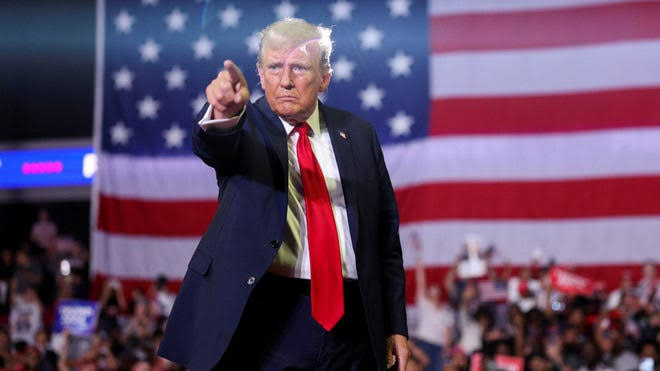
Trump Has A Clear Chance of Retaking the White House
Although we may well see a reversal in the national polls, it is important to remember that Trump does not need to win the national popular vote to win the election. In 2016, he lost the popular vote, but won the presidency in the electoral college - just as President George Bush did in 2000.
Democrats were sure that former President Donald Trump’s conviction on 34 felony counts in a New York courtroom on May 30 would see independent voters abandon him in droves. He is now a convicted felon, and although the verdict will likely be reversed upon appeal, there is little likelihood that will happen before Election Day. No reasonable person would vote for a convict, right?
Much to the Democrats’ chagrin, a lot of reasonable people plan to do just that. Not only will they vote for a felon, but they’ll send him lots of money to make sure he wins. In the 24 hours after the verdict, his campaign raised $53 million online.
And since then, he has closed the fundraising gap with President Joe Biden. According to Federal Election Commission filings, the Biden campaign, the Democratic Committee, and affiliated groups raised $85 million in May. This figure was dwarfed by the $141 million taken in by the Trump campaign, the Republican National Committee, and associated groups. At the end of May, the Trump campaign had $116.6 million in cash on hand compared to $91.6 million for the Biden campaign.
On Tuesday, the New York Times reported that Dr. Miriam Adelson, the widow of billionaire casino magnate and Republican megadonor Sheldon Adelson, plans to spend $100 million to put Trump back in the White House. In return for her support, she has requested that Trump “be less bombastic,” according to the report.
It is true that the national polls tightened slightly after the verdict, suggesting that, at least initially, some voters were reluctant to support a candidate who had been convicted of a crime. On May 30, Trump led Biden by 0.9% in the RealClearPolitics head-to-head average of polls. His lead dipped to 0.3% over the next week. Today, however, Trump’s lead stands at 1%. (It should be noted that Trump received a big boost last week from a Rasmussen Reports poll that showed Trump ahead by 9 points nationally, a result that may be an outlier.)
Trump’s May 30 lead of 2.2% in a five-way race also fell slightly in the week after the verdict, but has since fully recovered. Again, the recent results from Rasmussen are included in this polling average. Extracting this poll from the average would indicate Trump’s lead has not yet returned to its pre-verdict level.
Remarkably, Trump’s slight loss of support in the national polls did not transfer over to polls in the swing states, where the presumptive Republican nominee has modestly increased his lead in the RealClearPolitics average from 3.1% on May 30 to 3.2% today.
Trump currently maintains a lead in six of the seven battleground states included in the RealClearPolitics average: Arizona +5.6%, Georgia +4%, Michigan +0.2%, Nevada +4.0%, North Carolina +5.8%, and Pennsylvania +2.8%, and Trump and Biden are tied in Wisconsin. It should be noted that the Wisconsin polling average contains what looks to be an overly enthusiastic result from a Quinnipiac survey released in early May that showed Biden up 6 points in the state.
With the exception of North Carolina, Biden won all of these states in 2020.
It’s also worth noting that the day after his conviction, Trump’s odds in the RealClearPolitics betting average dived by 8.5%. He has not only regained this lost ground, but he is now 3 points higher than he was pre-verdict. His odds of winning in November stand at 51.2% compared to Biden’s chances of 35.5%.
Although we may well see a reversal in the national polls, it is important to remember that Trump does not need to win the national popular vote to win the election. In 2016, he lost the popular vote, but won the presidency in the electoral college – just as President George Bush did in 2000.
Moreover, with recent polls showing Trump tied with Biden in the states of Virginia and Minnesota and even gaining momentum in other traditionally blue states, Trump may be on the verge of expanding the electoral map for Republicans. Considering that Biden won Virginia by 9.4 points in 2020, and former Secretary of State Hillary Clinton won it by 5.3 points in 2016, the fact that Trump is even competitive in the state is stunning.
It’s not crazy to think that Trump could turn Virginia red again. Prior to electing President Barack Obama in 2008, the Old Dominion State had a long history of voting for Republicans. With the exception of President Lyndon Johnson’s 1964 victory, Virginians voted for the Republican candidate in every presidential election from 1952 to 2004.
RealClearPolitics recently moved Virginia from its “Leans Biden” category into the tossup column, where Biden is currently ahead in the average of polls by 2.2%. But two of the four polls included in the average (that show Biden leading by 3 and 6 points) were conducted in December.
A poll released last week from TheHill/Emerson, meanwhile, showed Trump and Biden tied in Minnesota, a state that hasn’t elected a Republican presidential candidate since President Richard Nixon in 1972.
Trump’s persistent strength in the battleground states and his recent surge in fundraising has to leave Democrats scratching their heads and wondering how it all went so wrong.
Perhaps Biden can explain it at Thursday night’s presidential debate when the two meet face to face in Atlanta.
Elizabeth Stauffer is a Research Fellow at the Sixteenth Council



